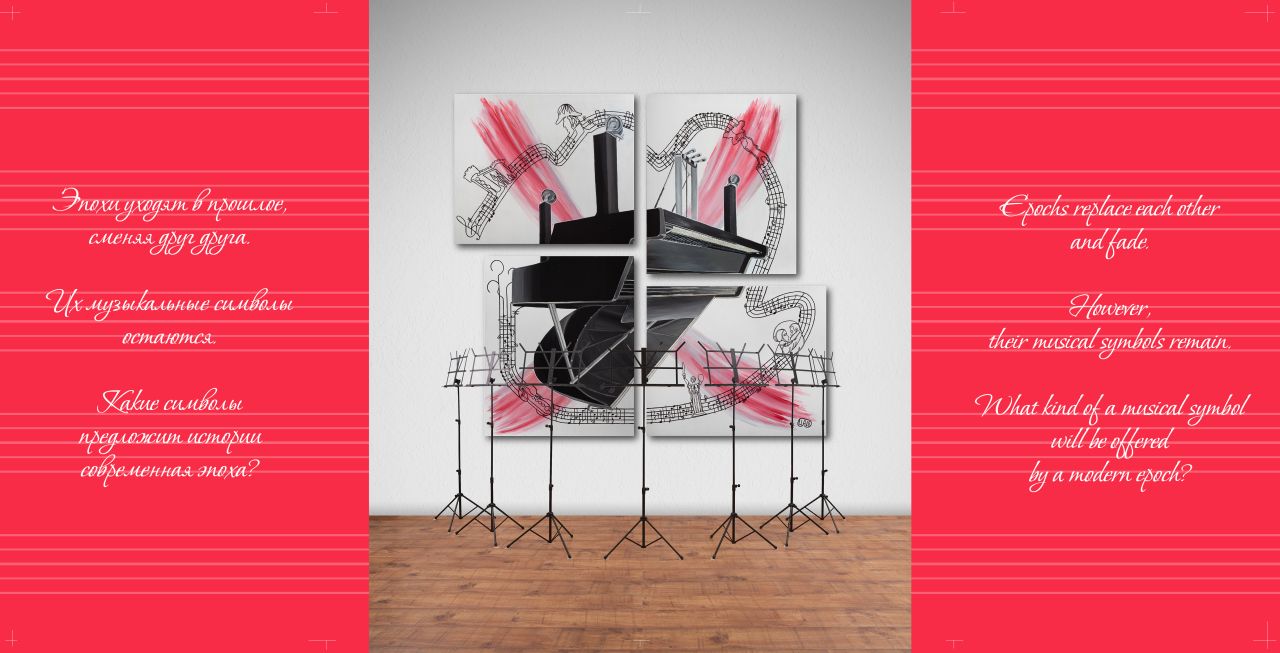Error
On September 21, 2018, the International Exhibition of Women's Art Numeri Esse opened at the Museum of History of the City of Kyiv. The exhibition is organized by the Ukrainian Association for Women's Studies in Art (UAFRA) led by curator and project manager Irina Akimova with the support of the Institute of Contemporary Art and the Kyiv organization of the National Union of Artists of Ukraine.
In the installation "Rhythms of Epochs" Irina Akimova offers philosophical reflections on musical symbols of different historical epochs, the change of which was accompanied by the rhythms of social upheavals.
Iryna Akimova's installation is an author's look at the rhythms of epochs through the prism of musical works. The epochs in which we live have their own rhythms. Calm and even, stormy and stormy, they intertwine into a single complex ever-changing social mosaic, as in a children's kaleidoscope, which from time to time shakes the hand of history. Their change is almost always accompanied by social upheavals or wars that destroy the old principles and break human lives and destinies. Each epoch gives birth to its own musical works, which absorb the full range of its hopes and events: hope for freedom and development, revolutionary calls for struggle, victorious triumphs and pain and longing for lost loved ones, who were ruthlessly crushed by the wheel of history. Ages are changing, the upside-down world is coming to its senses and preparing for new changes. But the rhythms of past epochs continue to live in the rhythms of music, which, remaining their symbol, acquires an independent sound.
The installation, based on the polyptych "Rhythms of Ages", tells about six musical symbols of different historical epochs. The central part of the polyptych - an inverted and divided into four parts piano - reminds the viewer of the rapid changes of historical periods, accompanied by the collapse of old worldviews, political alliances, empires and states, torn by human destinies and traditions. Everything that seemed inviolable and established, turns upside down, spreads in different directions to create a new mosaic of rhythms of life in the future. The large cross in the background, made in gray and red tones with careless long strokes, contrasts with the clear and elegant lines of the piano. It symbolizes the brute force of history, pushing forward the change of epochs through gunpowder smoke and bloody alarms. The band of musical notation with the first bars of famous musical works, encircling the central composition - is the image of Music, which invariably accompanies the development of society and which is destined to survive the era of its creators.
The musical narrative begins with "Marseilles" (written by Claude Joseph Rouge de Lille), which embodied the revolutionary romance and spirit of the French Revolution. At the same time, the text of "Marseilles", which calls for the shedding of the blood of enemies, involuntarily foresaw the huge human sacrifices associated with the revolution. The era has changed, and the melody has remained a symbol of the struggle for freedom. "Marseille" is the national anthem of the French Republic.
The second musical symbol is the Radetsky March, written by Strauss, the father, not as a revolutionary anthem. Its melody is rather a triumph of the rhythms of the traditional imperial order, which were restored after the successful suppression of the uprising in Italy. This bravura and major march became a symbol of the era of suppression of the liberation revolutions of 1848-1849. The era is over, and the march still remains popular and annually sounds like the final note of the New Year's concert of the Vienna Philharmonic Orchestra.
The Va, pensiero slave choir from Giuseppe Verdi's Nabucco became the anthem of the Risorgimento era, which ended with the conquest of independence and the reunification of Italy. It is still a symbol of the pursuit of national unity and freedom and remains the unofficial national anthem of Italy. revolutions and new totalitarian regimes.
The song "Holy War" (authors AV Alexandrov, VI Lebedev-Kumach) appeared as a call to defend the homeland on the fronts of World War II. This song has become a kind of symbol of the era of clashes between totalitarian regimes and deadly conflicts, which took from 50 to 80 million lives.
TheBeatles' song YellowSubmarine appeared in an era of ideological breakdown and violent student unrest in the late 1960s, which swept across the United States and Western Europe under left-wing radical slogans. Its popularity has made it a kind of symbol of the era of hippies and counterculture.
Ages go into the past, replacing each other. Their musical rhythms and symbols remain. What symbols will the modern era offer to history?



















